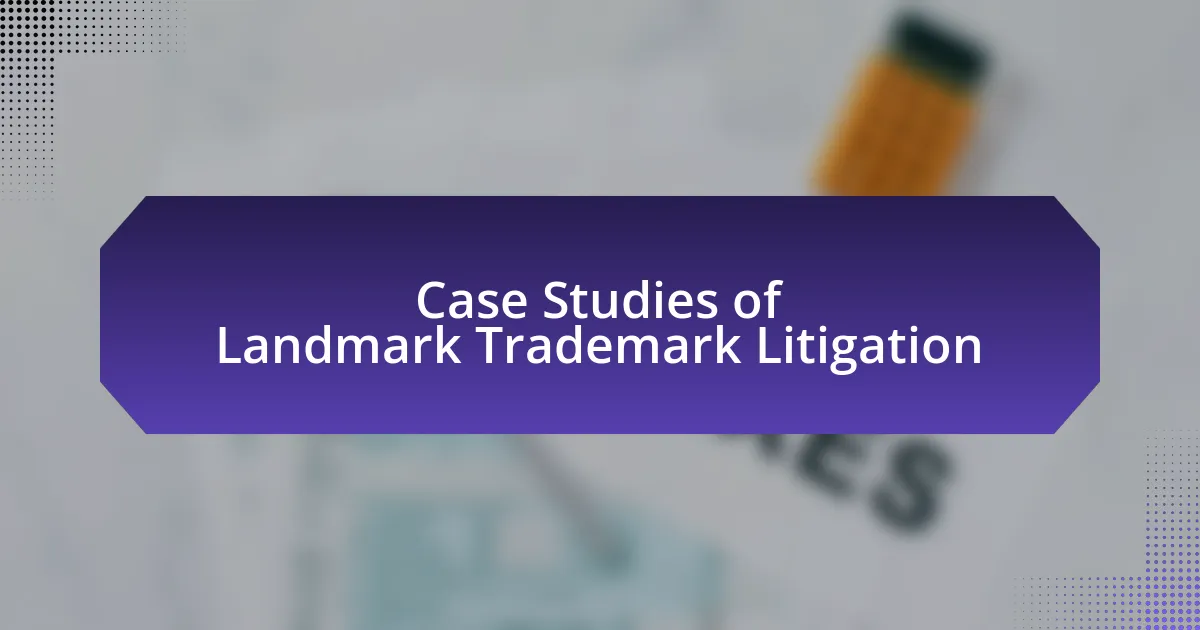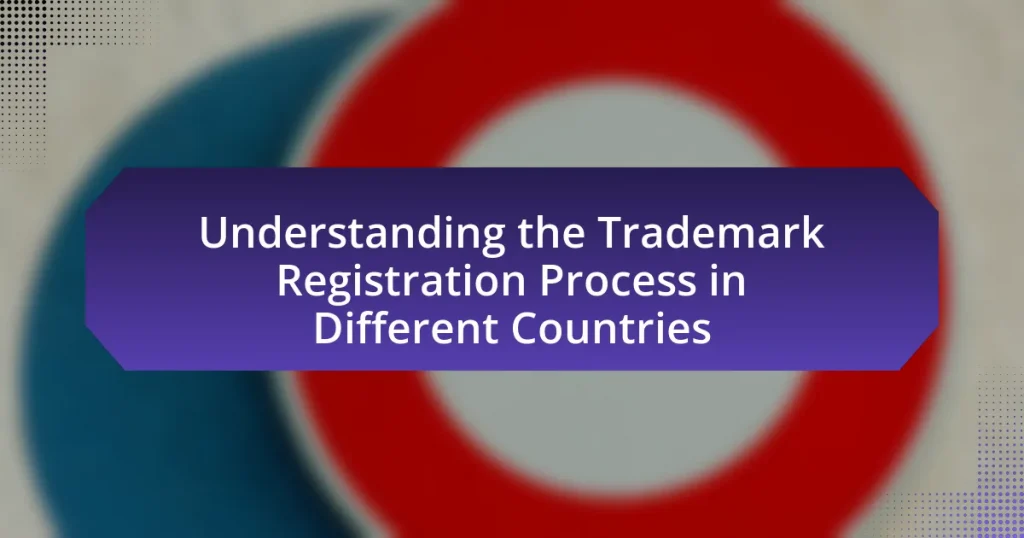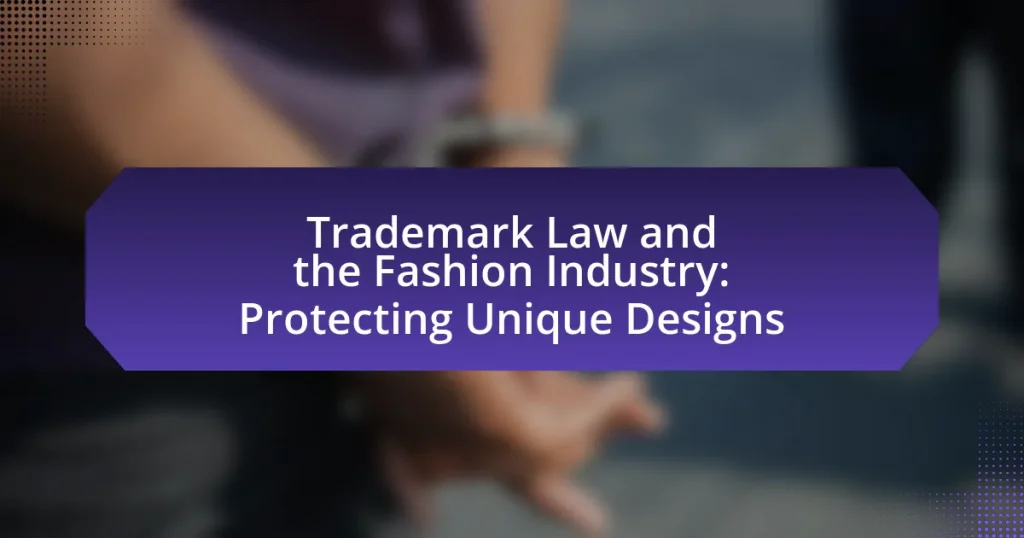Landmark trademark litigation cases are pivotal legal disputes that have significantly influenced trademark law and its interpretation across various jurisdictions. This article examines notable cases such as “Qualitex Co. v. Jacobson Products Co.” and “Matal v. Tam,” highlighting their implications for trademark protection, brand identity, and the balance between consumer rights and free speech. It also discusses the impact of these cases on businesses, including the necessity for robust trademark strategies and compliance with legal standards. Key characteristics of landmark cases, their influence on public perception, and lessons learned from specific disputes like Coca-Cola vs. Koke and Apple vs. Samsung are also analyzed, providing a comprehensive overview of how these legal precedents shape the current landscape of trademark law.
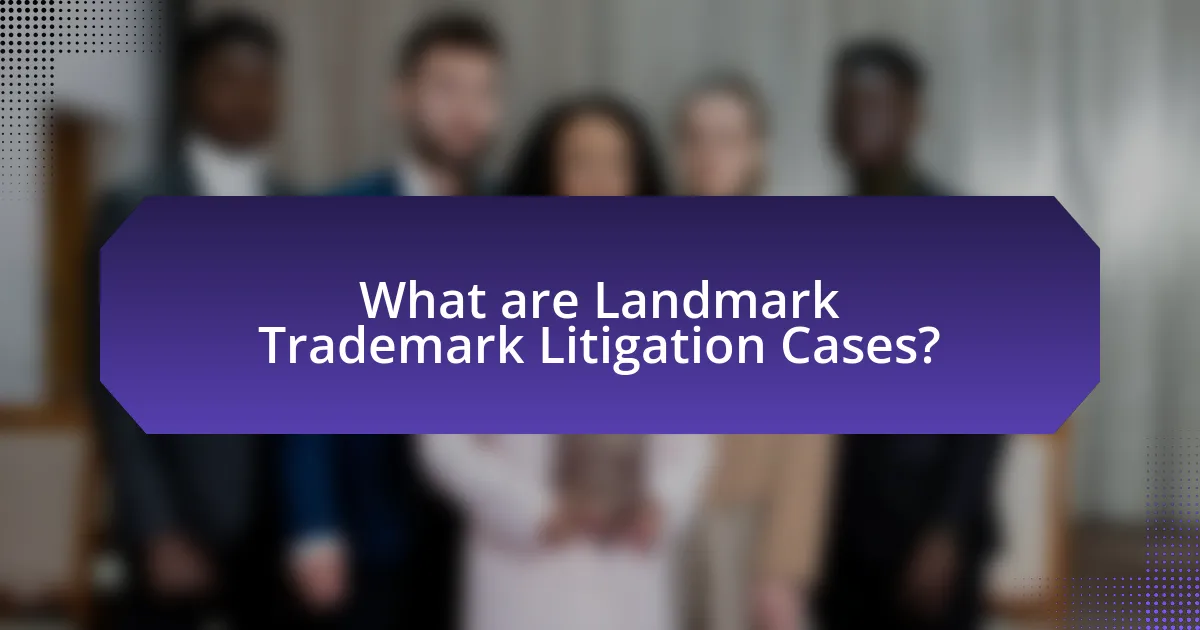
What are Landmark Trademark Litigation Cases?
Landmark trademark litigation cases are significant legal disputes that have shaped trademark law and its interpretation in various jurisdictions. These cases often involve high-profile brands and address critical issues such as trademark infringement, dilution, and the scope of trademark protection. For instance, the case of “Qualitex Co. v. Jacobson Products Co.” established that a color can be trademarked if it serves a source-identifying function, influencing how color trademarks are treated in subsequent cases. Another notable case, “Matal v. Tam,” affirmed the principle of free speech in trademark registration, ruling that disparaging trademarks cannot be denied registration based solely on their content. These landmark cases serve as precedents that guide future trademark litigation and influence the legal landscape surrounding intellectual property rights.
How do Landmark Trademark Litigation Cases impact businesses?
Landmark trademark litigation cases significantly impact businesses by establishing legal precedents that shape brand protection and competitive practices. For instance, the 2014 case of Mattel, Inc. v. MCA Records, Inc. clarified the boundaries of trademark use in artistic expression, influencing how companies navigate branding in creative industries. Such rulings can lead to increased litigation costs, changes in marketing strategies, and adjustments in product development to avoid infringement. Additionally, landmark cases often result in heightened awareness of intellectual property rights, prompting businesses to invest more in legal protections and compliance measures.
What are the key characteristics of Landmark Trademark Litigation Cases?
Landmark trademark litigation cases are characterized by their significant impact on trademark law, often involving high-profile brands and complex legal principles. These cases typically address issues such as trademark infringement, dilution, and the balance between consumer protection and free speech. For example, the case of Tiffany & Co. v. eBay Inc. highlighted the responsibilities of online marketplaces in preventing trademark infringement, setting a precedent for future e-commerce regulations. Additionally, landmark cases often result in changes to legal standards or interpretations, influencing how trademarks are protected and enforced across jurisdictions.
How do these cases influence trademark law?
Landmark trademark litigation cases significantly influence trademark law by establishing legal precedents that shape the interpretation and enforcement of trademark rights. For instance, the Supreme Court’s decision in the case of Qualitex Co. v. Jacobson Products Co. (1995) affirmed that color can be trademarked, thereby expanding the scope of what constitutes a trademark. This ruling has led to a broader understanding of trademark protection, allowing businesses to protect unique branding elements beyond traditional logos and names. Additionally, cases like Tiffany v. eBay (2010) clarified the responsibilities of online marketplaces in relation to trademark infringement, influencing how e-commerce platforms manage trademark rights. These cases collectively contribute to the evolving landscape of trademark law, guiding future litigation and legislative developments.
Why are certain Trademark Litigation Cases considered Landmark?
Certain trademark litigation cases are considered landmark because they establish significant legal precedents that shape the interpretation and enforcement of trademark laws. For example, the case of Qualitex Co. v. Jacobson Products Co. (1995) set a precedent by affirming that color can be trademarked, thereby expanding the scope of what constitutes a trademark. Landmark cases often address unresolved legal questions, influence future rulings, and impact the business practices of companies, making them pivotal in the evolution of trademark law.
What criteria determine the landmark status of a trademark case?
The criteria that determine the landmark status of a trademark case include the case’s impact on trademark law, its influence on subsequent legal decisions, and its role in shaping public policy regarding intellectual property. Landmark cases often set precedents that clarify legal standards, such as the definition of trademark infringement or the requirements for trademark registration. For instance, the Supreme Court’s decision in Qualitex Co. v. Jacobson Products Co. established that color can be trademarked, significantly influencing how trademarks are understood and applied in various industries. This case exemplifies how landmark status is achieved through a combination of legal significance and broader implications for trademark jurisprudence.
How do landmark cases shape public perception of trademarks?
Landmark cases shape public perception of trademarks by establishing legal precedents that influence how consumers and businesses understand brand identity and protection. For instance, the 1989 case of Qualitex Co. v. Jacobson Products Co. clarified that color can be trademarked, which expanded the scope of trademark protection and influenced consumer recognition of brands through color association. This case demonstrated that trademarks are not limited to words or logos, thereby altering public perception to recognize a broader range of brand identifiers. Additionally, the 2003 case of Mattel, Inc. v. MCA Records, Inc. reinforced the idea that trademarks must balance protection with free expression, impacting how the public views the relationship between brands and creative works. These landmark rulings not only shape legal standards but also inform consumer expectations and brand strategies, ultimately influencing how trademarks are perceived in society.
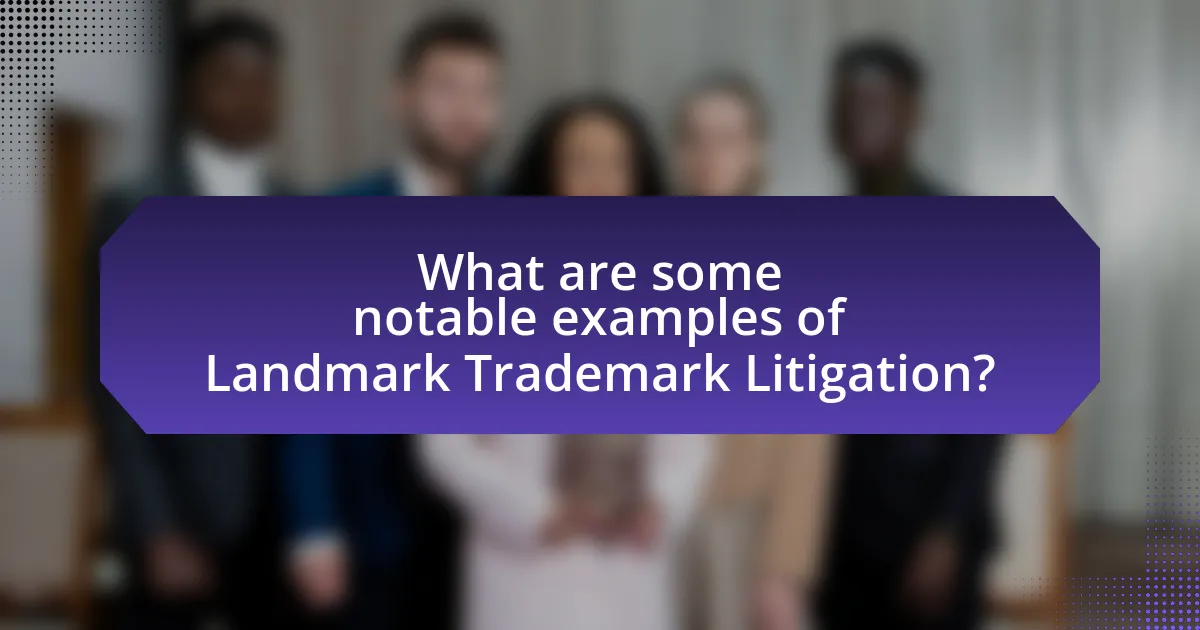
What are some notable examples of Landmark Trademark Litigation?
Notable examples of landmark trademark litigation include the case of Coca-Cola Company v. Koke Company of America, where the Supreme Court ruled on the distinctiveness of trademarks, affirming that a trademark must be capable of distinguishing goods. Another significant case is Qualitex Co. v. Jacobson Products Co., where the Supreme Court held that color can be trademarked if it serves a source-identifying function. Additionally, the case of Mattel, Inc. v. MCA Records, Inc. addressed the balance between trademark rights and artistic expression, ultimately ruling in favor of MCA Records, allowing the use of “Barbie” in a song. These cases have shaped the legal landscape of trademark law by establishing important precedents regarding trademark distinctiveness, color as a trademark, and the intersection of trademark rights with free speech.
How did the Apple vs. Samsung case redefine trademark boundaries?
The Apple vs. Samsung case redefined trademark boundaries by establishing clearer distinctions between design patents and trademark protections. The litigation highlighted the importance of visual design elements in branding, leading to a more stringent interpretation of what constitutes trademark infringement. Specifically, the U.S. Supreme Court’s involvement clarified that a product’s overall appearance could be protected under trademark law, as seen in the 2016 ruling that allowed Apple to claim damages based on Samsung’s use of similar design features. This case set a precedent for future trademark disputes, emphasizing the need for companies to carefully consider their design choices to avoid infringement claims.
What were the main arguments presented in the Apple vs. Samsung case?
The main arguments presented in the Apple vs. Samsung case centered around patent infringement and design copying. Apple accused Samsung of infringing on several of its patents related to smartphone technology, including features like pinch-to-zoom and the overall design of the iPhone. Samsung countered by claiming that Apple’s patents were invalid and that Apple had infringed on its own patents. The case highlighted issues of intellectual property rights in the tech industry, with Apple seeking damages and an injunction against Samsung’s products. The jury ultimately awarded Apple over $1 billion in damages, underscoring the significance of design and utility patents in the competitive smartphone market.
What was the outcome and its implications for future cases?
The outcome of landmark trademark litigation often results in the clarification of trademark laws and the establishment of precedents that influence future cases. For instance, a significant ruling may define the scope of trademark protection, impacting how similar cases are adjudicated. This can lead to stricter enforcement of trademark rights or, conversely, a more lenient approach depending on the specifics of the case. Such outcomes shape the legal landscape, guiding businesses in their branding strategies and influencing how courts interpret trademark infringement and dilution in subsequent litigation.
What lessons can be learned from the Coca-Cola vs. Koke case?
The Coca-Cola vs. Koke case illustrates the importance of trademark protection and the need for distinct branding. Coca-Cola successfully argued that Koke’s use of a similar name could confuse consumers, leading to a dilution of its brand identity. This case underscores the necessity for companies to rigorously defend their trademarks to maintain market position and consumer trust, as established by the court’s ruling that emphasized the significance of brand recognition in consumer choices.
What were the key legal issues in the Coca-Cola vs. Koke case?
The key legal issues in the Coca-Cola vs. Koke case revolved around trademark infringement and unfair competition. Coca-Cola argued that Koke’s use of the name “Koke” was likely to confuse consumers and dilute the Coca-Cola brand, as it closely resembled its own trademarked name “Coca-Cola.” The case highlighted the importance of protecting established trademarks from unauthorized use that could mislead consumers. The court ultimately ruled in favor of Coca-Cola, reinforcing the principle that trademarks must be safeguarded to maintain brand integrity and consumer trust.
How did this case affect brand identity and trademark protection?
This case significantly impacted brand identity and trademark protection by establishing clearer guidelines for the distinctiveness required for trademarks. The ruling emphasized that a strong brand identity is crucial for legal protection, as it must be capable of distinguishing goods or services in the marketplace. For instance, the court’s decision reinforced the necessity for brands to demonstrate unique characteristics that set them apart from competitors, thereby enhancing their legal standing in trademark disputes. This case serves as a precedent, illustrating that brands with distinctive identities are more likely to receive robust trademark protection, which ultimately influences how companies develop and maintain their brand strategies.
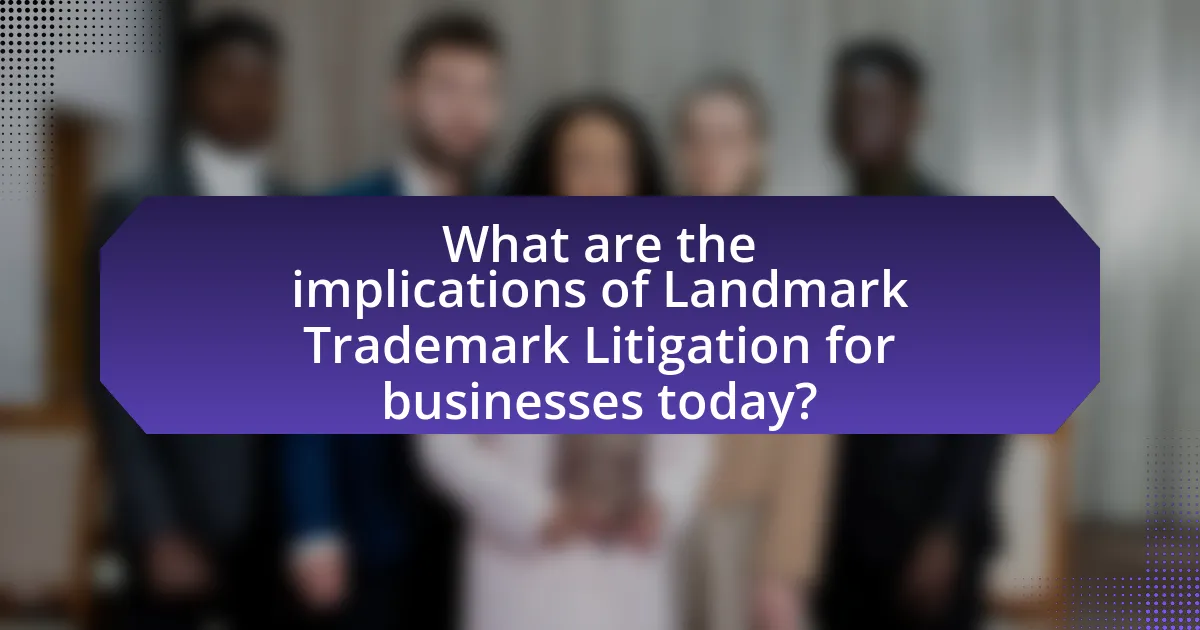
What are the implications of Landmark Trademark Litigation for businesses today?
Landmark trademark litigation has significant implications for businesses today, primarily influencing brand protection strategies and competitive practices. Businesses must navigate the complexities of trademark law to avoid infringement, as landmark cases often set precedents that redefine the scope of trademark rights. For instance, the Supreme Court’s decision in Matal v. Tam (2017) clarified the boundaries of free speech in trademark registration, impacting how companies approach branding and marketing. Additionally, landmark cases can lead to increased litigation costs and necessitate more robust legal strategies to safeguard intellectual property. As a result, businesses are compelled to invest in legal counsel and compliance measures to mitigate risks associated with trademark disputes.
How can businesses prepare for potential trademark litigation?
Businesses can prepare for potential trademark litigation by conducting thorough trademark searches and registrations, ensuring their trademarks are distinctive and not infringing on existing marks. This proactive approach minimizes the risk of disputes. According to the United States Patent and Trademark Office, conducting a comprehensive search can reveal potential conflicts, allowing businesses to adjust their branding strategies accordingly. Additionally, businesses should maintain proper documentation of their trademark use and monitor the market for potential infringements, as this evidence can be crucial in litigation. Legal counsel specializing in intellectual property can provide guidance on best practices and risk management strategies, further strengthening a business’s position in the event of a dispute.
What strategies can companies employ to protect their trademarks?
Companies can employ several strategies to protect their trademarks, including registering trademarks with the appropriate governmental authorities, actively monitoring the market for potential infringements, and enforcing their rights through legal action when necessary. Registering trademarks provides legal recognition and exclusive rights, which can deter unauthorized use. Monitoring involves keeping an eye on similar marks and products to identify potential violations early. Legal enforcement, such as sending cease-and-desist letters or pursuing litigation, reinforces the company’s commitment to protecting its brand and can prevent dilution or confusion in the marketplace. These strategies are essential for maintaining brand integrity and ensuring long-term business success.
How can understanding landmark cases inform trademark strategy?
Understanding landmark cases can significantly inform trademark strategy by providing insights into judicial reasoning, precedent, and the application of trademark law. For instance, cases like Qualitex Co. v. Jacobson Products Co. established that color can be trademarked, influencing businesses to consider color as a strategic element in branding. Additionally, the Matal v. Tam decision clarified the boundaries of free speech in trademark registration, guiding companies on the implications of using potentially controversial marks. These cases serve as critical references for legal counsel and brand managers, enabling them to navigate trademark applications, enforcement, and potential litigation with a clearer understanding of the legal landscape and risks involved.
What best practices should businesses follow regarding trademarks?
Businesses should conduct thorough trademark searches before adopting a mark to ensure it does not infringe on existing trademarks. This practice helps avoid legal disputes and potential rebranding costs. Additionally, businesses should register their trademarks with the appropriate government authorities, such as the United States Patent and Trademark Office, to gain legal protection and exclusive rights to use the mark in commerce. Regular monitoring of the trademark’s use in the market is also essential to identify any unauthorized use or infringement, allowing for timely enforcement actions. Furthermore, businesses should maintain proper documentation of their trademark use and renew registrations as required to preserve their rights. These practices are supported by the fact that companies with registered trademarks are more likely to succeed in litigation, as seen in cases like the Coca-Cola Company v. Koke Co. of America, where trademark registration played a crucial role in the outcome.
How can businesses ensure compliance with trademark laws?
Businesses can ensure compliance with trademark laws by conducting thorough trademark searches before launching products or services. This process involves checking existing trademarks to avoid infringement, which is crucial as over 1.5 million trademarks were registered in the United States as of 2022. Additionally, businesses should implement internal policies for trademark usage, provide employee training on trademark rights, and regularly monitor the market for potential infringements. Legal counsel specializing in intellectual property can also assist in navigating complex trademark regulations, ensuring that businesses adhere to both federal and state laws.
What common pitfalls should businesses avoid in trademark management?
Businesses should avoid the common pitfalls of neglecting trademark searches, failing to monitor trademark usage, and not enforcing trademark rights. Neglecting comprehensive trademark searches can lead to conflicts with existing trademarks, resulting in costly litigation, as seen in the case of the “Apple Corps vs. Apple Computer” dispute. Failing to monitor how trademarks are used can dilute brand identity and weaken legal protection, evidenced by the “Kraft Foods Group Brands LLC v. Cracker Barrel Old Country Store, Inc.” case, where lack of vigilance allowed for brand confusion. Not enforcing trademark rights can lead to loss of exclusivity, as demonstrated in the “McDonald’s Corp. v. McBagel’s” case, where failure to act against infringers diminished the strength of the trademark.
